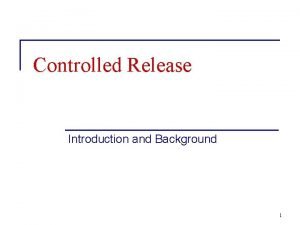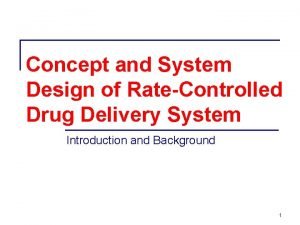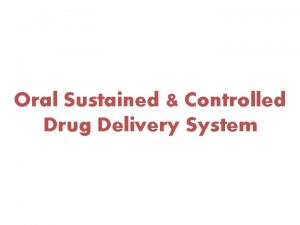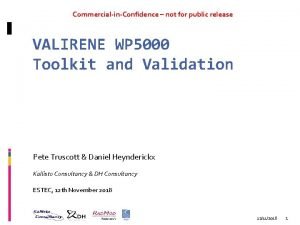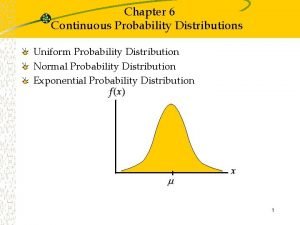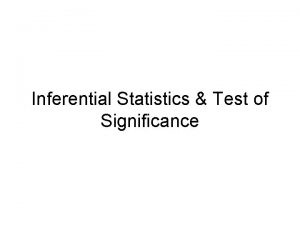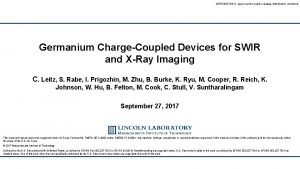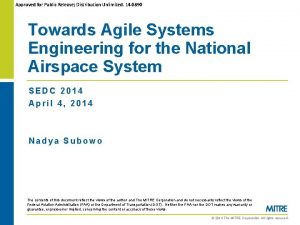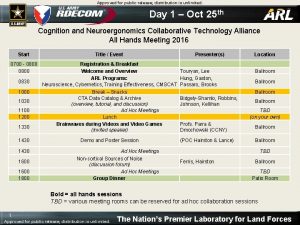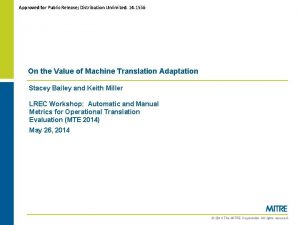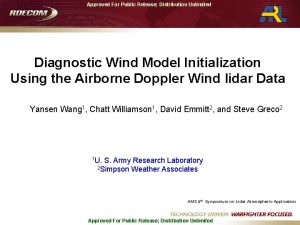APPROVED FOR PUBLIC RELEASE DISTRIBUTION IS UNLIMITED BioDerived

APPROVED FOR PUBLIC RELEASE; DISTRIBUTION IS UNLIMITED Bio-Derived Isosorbide Methacrylate Has Excellent Properties Isosorbide methacrylate (IM) Viscosity at RT (c. P) • IM has extremely low viscosity • Low IM viscosity because of lack of Hbonding 100000 10000 Lowest ever viscosity for methacrylate crosslinker 1000 48000 295 147 100 Previous Tg max 10000 Highest ever 0. 12 Tg for a VE 0. 1 Resin! 255°C 0. 08 100 0. 06 10 0. 04 Storage Modulus (MPa) 1 0. 02 Loss Modulus (MPa) Tan Delta 0. 1 0 0 100 200 300 Temperature (°C) APPROVED FOR PUBLIC RELEASE; DISTRIBUTION IS UNLIMITED 400 Tan d Modulus (MPa) 1000 IM VE/styrene VE Sadler, J. M. et al. Journal of Materials Chemistry A, (2013) 1, 12579 -12586 • Eliminates need for volatile diluents • Enables cheaper processing • Enables use near engine components, etc. • High temp epoxy performance at 1/10 th cost The Nation’s Premier Laboratory for Land Forces

APPROVED FOR PUBLIC RELEASE; DISTRIBUTION IS UNLIMITED Pros and Cons of IM and Methacrylates Pros: • IM has very high Tg • IM has very low viscosity Cons • All methacrylates require separations to remove unwanted by products This technology described herein eliminates the “Cons” of methacrylates APPROVED FOR PUBLIC RELEASE; DISTRIBUTION IS UNLIMITED The Nation’s Premier Laboratory for Land Forces

APPROVED FOR PUBLIC RELEASE; DISTRIBUTION IS UNLIMITED Typical Methacrylate Preparation 4 -DMAP + + 40 -60°C TEA, DCM + 0 -25°C + HCl Separations step necessary to remove • Solvent-aqueous liquid-liquid extraction generally required to extract HCl from methacrylate or to separate out methacrylic acid from methacrylate product. • Separation process increases cost by factor of ~2. APPROVED FOR PUBLIC RELEASE; DISTRIBUTION IS UNLIMITED The Nation’s Premier Laboratory for Land Forces

APPROVED FOR PUBLIC RELEASE; DISTRIBUTION IS UNLIMITED Novel IM Methacrylate Preparation + 4 -DMAP 40 -60°C + AMC-2 or imidizole 70 -95°C • An epoxy is added to the IM/methacrylic acid mix. The epoxy and methacrylic acid react to form a mono-methacrylate reactive diluent. • Method eliminates need for separation of methacrylic acid (or HCl) • Reactive diluents are typically added to crosslinkers to help produce a well cured thermoset. APPROVED FOR PUBLIC RELEASE; DISTRIBUTION IS UNLIMITED The Nation’s Premier Laboratory for Land Forces

APPROVED FOR PUBLIC RELEASE; DISTRIBUTION IS UNLIMITED Use of other Alcohols + + 4 -DMAP + 40 -60°C + + AMC-2 or imidizole 70 -95°C • Mono alcohols will produce reactive diluents • Diols will produce crosslinking agents • Both will modify the resulting resin properties APPROVED FOR PUBLIC RELEASE; DISTRIBUTION IS UNLIMITED The Nation’s Premier Laboratory for Land Forces

APPROVED FOR PUBLIC RELEASE; DISTRIBUTION IS UNLIMITED Novel IM Methacrylate Preparation • Mono epoxies produce reactive diluent • Diepoxies react to produce dimethacrylate crosslinkers • Use of mono- and di-epoxies allow tuning of the resin composition, crosslinker content, viscosity, and polymer properties. APPROVED FOR PUBLIC RELEASE; DISTRIBUTION IS UNLIMITED The Nation’s Premier Laboratory for Land Forces

APPROVED FOR PUBLIC RELEASE; DISTRIBUTION IS UNLIMITED IM + DGEBA and PGE + Epoxy compound: - Will consume methacrylic acid + - Will produce reactive diluents or crosslinkers that Phenyl glycidyl ether (PGE) can copolymerize with IM - Any epoxy compound can be used + DGEBA or Epon AMC-2 or imidizole Vinyl ester of PGE (VE-PGE) 70 -95°C + + APPROVED FOR PUBLIC RELEASE; DISTRIBUTION IS UNLIMITED Vinyl ester of DGEBA (VE) The Nation’s Premier Laboratory for Land Forces

APPROVED FOR PUBLIC RELEASE; DISTRIBUTION IS UNLIMITED Novel IM Preparation – Properties • • Method results in resins where low viscosities are achievable. Viscosities are tunable depending on the alcohols and epoxies used. IM + epoxy methacrylates made using new method Baseline VE IM + epoxy methacrylates made using new method Baseline IM Baseline VE • • Method results in polymers where high Tg is achievable. Tg is tunable depending on the alcohols and epoxies used. IM enables increased Tg with reduced viscosity! APPROVED FOR PUBLIC RELEASE; DISTRIBUTION IS UNLIMITED The Nation’s Premier Laboratory for Land Forces

APPROVED FOR PUBLIC RELEASE; DISTRIBUTION IS UNLIMITED Benefits and Applications • Elimination of acid, tunable viscosity, and tunable polymer properties. • Use of IM enables attainment of very high Tgs and low viscosities • Reduces cost of the resins vs. that of pure IM or other methacrylate systems because method eliminates costly separation step. • IM has low toxicity and is bio-derived • Provides benefits for the following applications • Composites – low viscosities allows resin flow through fibers. Higher Tg allows for higher temperature use. • Adhesives – higher temperature applications. • Additive manufacturing resins (stereolithography and ink jet printing) – IM is very beneficial in this application because it does not have phenolic rings that reduce rate and extent of cure during photo curing. APPROVED FOR PUBLIC RELEASE; DISTRIBUTION IS UNLIMITED The Nation’s Premier Laboratory for Land Forces
- Slides: 9

